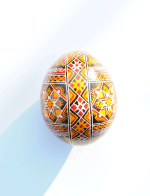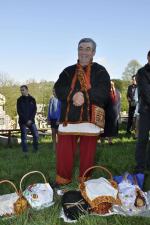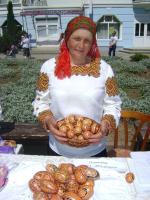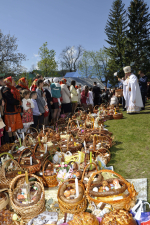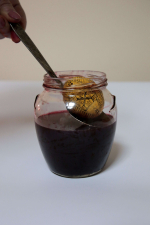Tradition of Hutsulska Pysanka
Video gallery
Tradition of Hutsulska Pysanka

Video gallery
Traditionally, pysankas are written by women and girls (rarely men and boys) during Lent. They write on a shell of raw whole eggs. The ornament is written by a “pysachok” (a stylus), filling with melted beeswax. Fragments of the ornament are painted and covered with beeswax to save colour. Bright yellow-orange, red colours with intersection of green colour on a black background prevail. Formerly, wax from pysanka was removed after heating in a stove, nowadays an oven or a candle flame are also used, and pysanka is wiped with a napkin after.
Each village of Hutsulshchyna has its local artistic and stylistic features, colour scheme, different variants of pysankas’ fragmentation into ornamental parts.
Pysanka is maintained as an inalienable symbol of Easter in a community from generation to generation. On Maundy Thursday children inform that in three days Easter will come, and hosts give them a pysanka for that. Easter baskets are necessarily filled with pysankas. For blessing of a basket the priest is presented with a pysanka. After sanctification elder and poor people are given a blessed pysanka and Easter paskha to pray for dead souls. Returning from a church, blessed pysankas are immersed in water. In some families, this water is used for washing; others put pysanky to their faces to be healthy and rich all year long. The custom, when girls on Easter Monday give pysankas to boys, has survived. After Easter, on Memorial Saturday, a family gives a pysanka and Easter paskha to someone, who is present near their relatives’ graves. “Writing” pysankas is an essential part of Hutsuls’ intangible cultural heritage. The tradition was spread throughout Hutsulshchyna: Kosiv, Verkhovyna, Nadvirna districts of Ivano-Frankivsk oblast, Putyla and Vyzhnytsia districts of Chernivtsi oblast, Rakhiv district of the Zacarpatska oblast. Today, the main centre of the element’s dissemination is the village Kosmach of Kosiv district in Ivano-Frankivsk oblast, where a lot of dynasties of pysanka artists and individual masters live. Academics of Pysanka museum registered 87 pysanka artists, who actively and creatively work. The tradition of decorating pysanka is widespread in many surrounding villages of Kosiv district, in particular - in Liucha, Prokurava, Shepit, Akreshory, Roztoky, Kuty, and Brusturiv. A well-known centre is also the village of Chornyi Potik of Nadvirna district.
Pysankas are “written” in Verkhovyna district in villages: Kryvorivnia, Krasnoillia, Bukovets, Verkhovyna. Traditional pysanka painting is also spread on the territory of Putylskyi and Vyzhnytskyi districts of Chernivtsi oblast. A lot of pysanka masters are known in Putylskyi district; in particular, the tradition is continued and developed in such villages: Pidzacharychi, Marynichi. In Vyzhnytskyi district - in an urban village of Beregomet, in villages of Vyzhenka and Chereshenka.
Pysanka masters are known in Rakhiv district of Zacarpatska oblast in the city of Rakhiv, urban villages of Velykyi Bychkiv and Kobyletska Poliana. Usually masters have students-followers who continue their teachers’ traditions.The majority of bearers are between 20 and 50 years old, the minority - are aged between 12 and 20 and between 50 and 80. All age groups belong to the category of community members who are interested in the element. A separate group consists of those who attend master classes on how to write pysankas; these are children aged 6-12, pupils and students of 13-22 years old, comparatively less those who are 25-60 years old.
Realizing the importance of preserving pysanka painting, scientists of Kolomyia museum in the 70's of the XXth century developed a program for collecting pysankas from all villages, where the traditions of pysanka “writing” still remained. The gathered 1155 items became basis of the collection of Pysanka Painting Museum, opened in 1987 (now National Museum of Hutsulshchyna and Pokuttia Folk Art named after Yo. Kobrinskyi). The museum began to organize thematic conferences, festivals, pysanka artists’ congresses, create school of pysankas decorating, and hold master classes. Some scientific publications and articles about pysanka have appeared.
An important role in preserving collection of pysankas played conservation method of raw eggs, invented in 1973 by the main guard of National Museum of Hutsulshchyna and Pokuttia Folk Art named after Yo. Kobrinskyi, Liubomyr Krechkovskyi, and a laboratory assistant of the museum's funds, Maria Boledziuk. The work is ongoing not only in the museum, but also during the business trips to masters, “before Easter” fairs, festivals.
The element is explored by researchers of National Museum of Hutsulshchyna and Pokuttia Folk Art named after Yo. Kobrinskyi, Pysanka Museum, other Ukrainian museums and scientific institutions, and researchers of folk art. The database of bearers is constantly updated and improved.Close cooperation with international institutions continues.
The museum has repeatedly represented Hutsul pysanka in the annual festival "Karpatska Kraslitsa" (Slovakia), in Swidnik (Slovakia), Opole (Poland), Ratingen, Düsseldorf, Lindlar, Köln (Germany), etc. with compulsory lectures and master classes on pysankas making.Every year Kolomyia hosts a folk festival "Pysanka", which holds conferences, round tables, contests for participants of pysanka painting clubs; “before Easter” fairs where you can buy pysankas from bearers of the tradition.
Kosmach – village of Kosiv district in Ivano-Frankivsk Oblast
Area: 84.31 sq. km.
Population: 6054
Population density: 71.81/ sq. km
Driving distance from Kiev to Kosmach: 599 km Lorem ipsum dolor sit amet. Expedita distinctio quae ab illo inventore. Molestias excepturi sint, obcaecati cupiditate non provident similique. Molestias excepturi sint, obcaecati cupiditate non provident, similique sunt. Doloribus asperiores repellat. molestias excepturi sint, obcaecati cupiditate non numquam. Nobis est laborum et iusto odio dignissimos. Cum soluta nobis est laborum et quas molestias excepturi sint, obcaecati cupiditate. Impedit, quo voluptas assumenda est, qui in culpa.



















